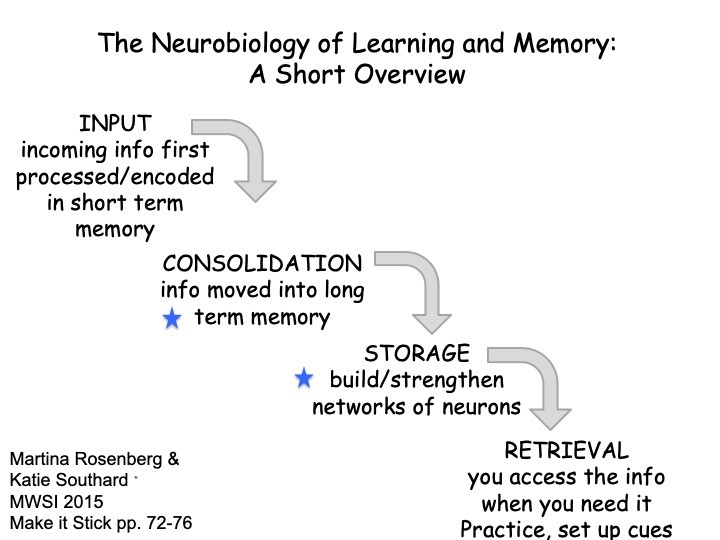October 2, 2020
Wow! We are essentially through week 6 of the semester!
Here are my favorite books on learning:
Small Teaching by James Lang (there is a new version for online teaching)
How Learning Works by Ambrose et al.
How Humans Learn by Joshua Euler
A Guide to Effective Studying and Learning by Rhodes et al
How We Learn by Benedict Carey
Make it Stick by Brown et al.
This Week’s Teaching Tip:
As promised, I am continuing my series on how students learn and how that informs our teaching practices with another core concept for successful teaching based on how students learn. My source for this week’s tip is the UC Berkeley (Cal) Center for Teaching and Learning website and the Lawrence Hall of Science/UC Berkeley NSF-WIDER grant funded Faculty Learning Program Teaching Excellence Colloquium workshop by Chelan Huddleston (UC, Berkeley, College of Letters and Science).
Core Concept: Memory and Recall

Let’s get a handle first on what we know about memory and recall.
There are two basic types of explicit, or declarative, memory (Explicit memory is the conscious, intentional recollection of factual information, previous experiences, and concepts). First, short term or working memory. Think of this as the focus of current attention, or what you are actively thinking about right now. Second, long term memory which is broken down further into semantic memory (facts) and episodic memory (specific events).
Within explicit, or declarative, memory, there are three basic stages of memory processing (see figure above). Encoding is the process of forming new memories. Storage comes next and is the process of information maintenance. And finally, there is the process of gaining access to stored knowledge, referred to as retrieval. For learning to take place, as we categorize it in this sense, it requires that the information that is processed is then committed to memory and that the student can pull it back out when it’s needed (and hopefully apply it to a novel circumstance through adaptation and abstraction).
By examining each part of memory and recall from encoding to storage to retrieval, we get a clear sense of how best to optimize this process for our students.
To make encoding a powerful process, it’s necessary to recognize that memories are NOT stored as faithful recordings, like a book you can pull off a shelf to share again as needed in their exact original form. Instead, each new memory is integrated into our existing body of knowledge – coloring and being colored by other memories. Therefore, the most robust memories are formed through elaboration and organization where learners:
- process the new information as deeply as possible,
- maximize connections with what is already known, and
- situate new knowledge into an existing framework.
The challenge with storage is that once something has made it into long-term memory, it tends to remain stored, but not necessarily always accessible. The challenge here is not one of capacity. In fact, our capacity for storing new memories is essentially unlimited, and more so, organized learning appears to create additional capacity. However, the ability to access a given memory typically declines over time, primarily due to interference caused by the acquisition of new, competing memories. Do not let this sour your hope of learners remembering what was learned in your class. You can markedly increase the likelihood of students being able to recall a memory at a future time by strengthening it through retrieval.
Retrieval is an active reconstruction process, not a playback of a memory of an event, fact, concept, or process. Every time a memory is accessed for retrieval, that process modifies the memory itself; essentially re-encoding the memory. The good news: Retrieval makes the memory itself more recallable in the future.
How does it work, and work best for learning? Retrieval is cue and context dependent – know this and how you can cue retrieval and provide the best context to strengthen memory. To reinforce memory through cues, we’re referring to making as many connections as possible with existing memories. The more possible cues available to elicit retrieval, the better. With regard to context, the more closely matched the retrieval context is with the context in which the memory was encoded, the better. This holds true even if you can only have one context (i.e., you only have one shot at retrieval – think high-stakes exam as sole measure of learning in a course). But, multiple retrievals in multiple contexts are superior for long-term retention (think frequent, low-stakes quizzes which are cumulative). Additionally, we can enable students to do this even better by encouraging them to vary the contexts of retrieval (e.g. studying method, physical location), which results in more accessible memories.
Please let me know if you have any comments or suggestions.
Have a great weekend, Paul
Paul Laybourn (he/him/his)
Professor, Biochemistry and Molecular Biology
Director, W2R S-STEM Program
Director, NoCo B2B Program
Co-Director, REU Site in Molecular Biosciences
paul.laybourn@colostate.edu
970-491-5100
